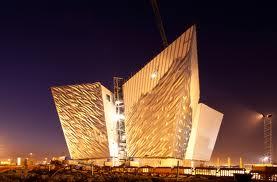 | |
| Titanic Belfast |
10th April, 2012
A new phenomenon in Belfast in recent years has been the development of 'quarters.' First we had what is now known as the Cathedral Quarter which, strangely enough, is near St. Anne's Cathedral to the north of the city centre. Like Dublin's Temple Bar area, this is an area of narrow cobbled streets, restaurants, old pubs and new pubs in old buildings, with music and other entertainment. Just opposite the cathedral is Writer's Square, with the names of local writers inlaid in the pavement, where music and arts events are held.On the other side of the city centre, bordering the Lower Ormeau area are a group of streets we've always referred to as the Holy Land – because it includes Jerusalem Street, Palestine Street, Damascus Street, Carmel Street and Cairo Street. This used to be a mixed residential area of small two and three story terraced houses, but it has changed dramatically over the last few years. Most of the original inhabitants have gone. A small number of immigrant families still live there, but the area has been invaded by several thousand students – from both Queen's University and the University of Ulster – as developers have converted and extended the small houses into student housing, leaving only the original facades unchanged.
The area is now officially part of what's known as Queen's Quarter, an area encompassing the buildings of Queen's University, a proposed new site for the University of Ulster, (which is currently outside the city), student accommodation and lots of bars, clubs and nightspots.
 |
| White Star Line poster of Titannic |
The Titanic was built in the Harland & Wolff shipyard in east Belfast – at that time the largest shipyard in the world. In 1910 Belfast was a boom town, a strong leader in engineering and linen manufacture as well as shipbuilding. At that time the Titanic was the largest and most luxurious liner in the world. The shipyard employed over 35,000 people in the early 1900s – including my grandfather!
The yard was founded in 1862 and has the world's largest dry dock and later the two huge yellow cranes, which dominate the Belfast skyline, manufactured by the German company, Kruup – Goliath (315 ft high) was the first, in 1969, followed by Sampson, in 1974 (348 ft high). Each crane spans 259 feet, can lift a load of 840 tons, and run on rails, driven by their own huge diesel engines inside the top of the main leg of each crane – two engines in each, one for backup.
 |
| Filming the Titanic Quarter from 300ft up on top of Goliath crane |
Seeing we had a once-in-a-lifetime chance to film from the top of the crane, we took guitars up with us and filmed each other performing on top of Goliath. At first it was beautiful sunny spring weather and I got some great footage of ships moving and a plane landing at the nearby George Best City Airport.
Unfortunately, when I was being filmed performing, not only did my guitar strap come adrift, but a sudden wintry squall came in around us, with strong winds and snow hitting us horizontally. We had to grab camera, tripod and guitars and scramble quickly for safety down the stairs to the engine platform at the top of the leg of the crane!
In 2007 the Goliath crane crashed into one of the smaller cranes – at 95 tonnes! – knocking it over in what could have been a lethal accident. (Check it out on YouTube under Harland & Wolff Crane Accident).
The Titanic was built in this dock, although smaller cranes were used in her construction, along with sister White Star Line ships, Olympic and Britannic; the Royal Navy cruiser, HMS Belfast; P&O's SS Canberra and dozens of other ships. Nowadays the yard deals more with refurbishing oil rigs and drilling ships and building wind farm components.
 Titannic left Belfast on the evening of 2nd April, 1912; calling at Southampton in England; Cherbourg, France; and finally Cobh, near Cork City, in the Republic of Ireland; before setting off across the Atlantic for Manhattan, New York City. She struck an iceberg at almost full speed on April 14th and sank two hours and forty minutes later, with the loss of more than 1,500 lives.
Titannic left Belfast on the evening of 2nd April, 1912; calling at Southampton in England; Cherbourg, France; and finally Cobh, near Cork City, in the Republic of Ireland; before setting off across the Atlantic for Manhattan, New York City. She struck an iceberg at almost full speed on April 14th and sank two hours and forty minutes later, with the loss of more than 1,500 lives.My great uncle, George Given, was booked to travel on the Titannic, but he was so eager to get to Canada that he travelled on an earlier ship instead. What a providential move that turned out to be, eh?
